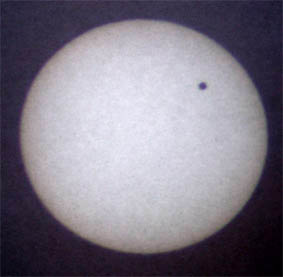The Transit of Venus

The transit of Venus, June 8, 2004. Photograph taken from Jerusalem by the author, using a 10x50 viewfinder having a 90° prism. The image passing the prism is projected onto a white piece of paper hung on a nearby wall. The image was then photographed with a consumer type camera.
The last opposition took place in 2004. The next one will take place in 2012 , afterwards, only our great grandchildren will be able to see the subsequent transits, in 2117 and 2125 AD.
On the right you'll find an image taken by the author during the June 8, 2004 transit. The silhouette of venus can clearly be seen. Another interesting phenomenon is the limb darkening, the fact that the edges of the solar disk are darker than the center part. This has to do with the fact that rays coming from the edge originate from higher up the atmosphere (because they traverse it obliquely), where the temperature and total emission are lower.
A few interesting anecdotes related to the transits of venus:
- First Predicted to occur in 1631 by Johanes Kepler, but first observed in 1639 by Horrocks and Crabtree.
- In the 1761 transition, Lomonosov detected the existence of an atmosphere on venus.
- Observing the transit of venus was one of the motives behind Captain Cook's visit to Tahiti. This is because simultaneous observations of the transit were used to measure the solar parallax and from it, the distance to the sun. (Observers at different locations [primarily different latitudes] observe different transit durations).
- Simultaneous transits of both venus and mercury will take place in July 26, 69163 AD, in a very long time!!
